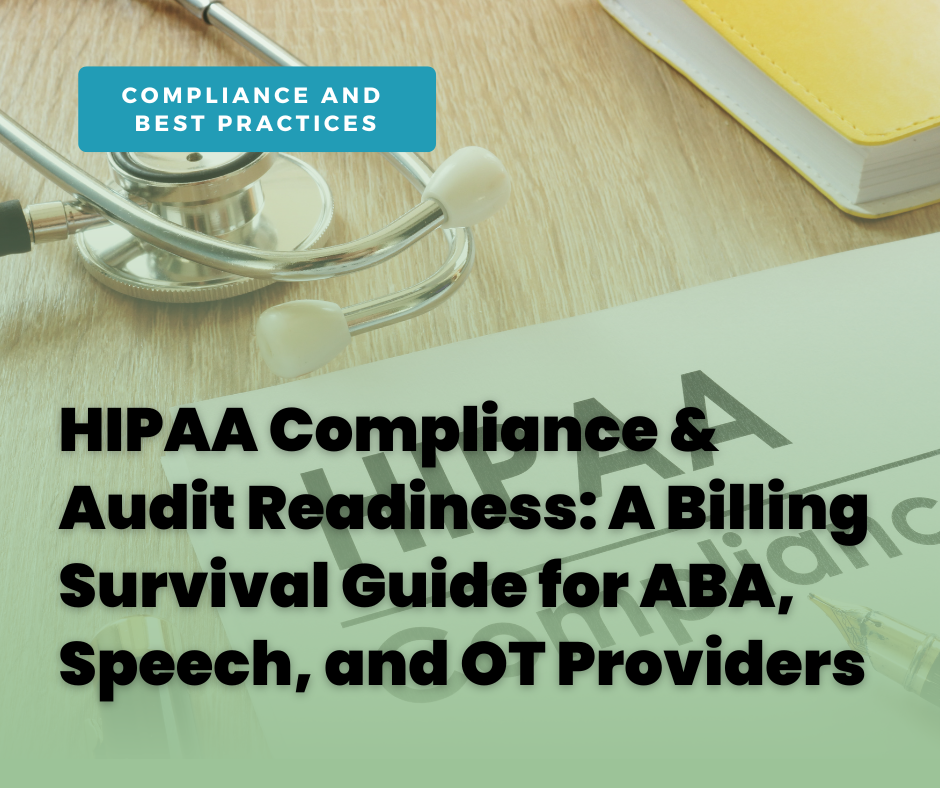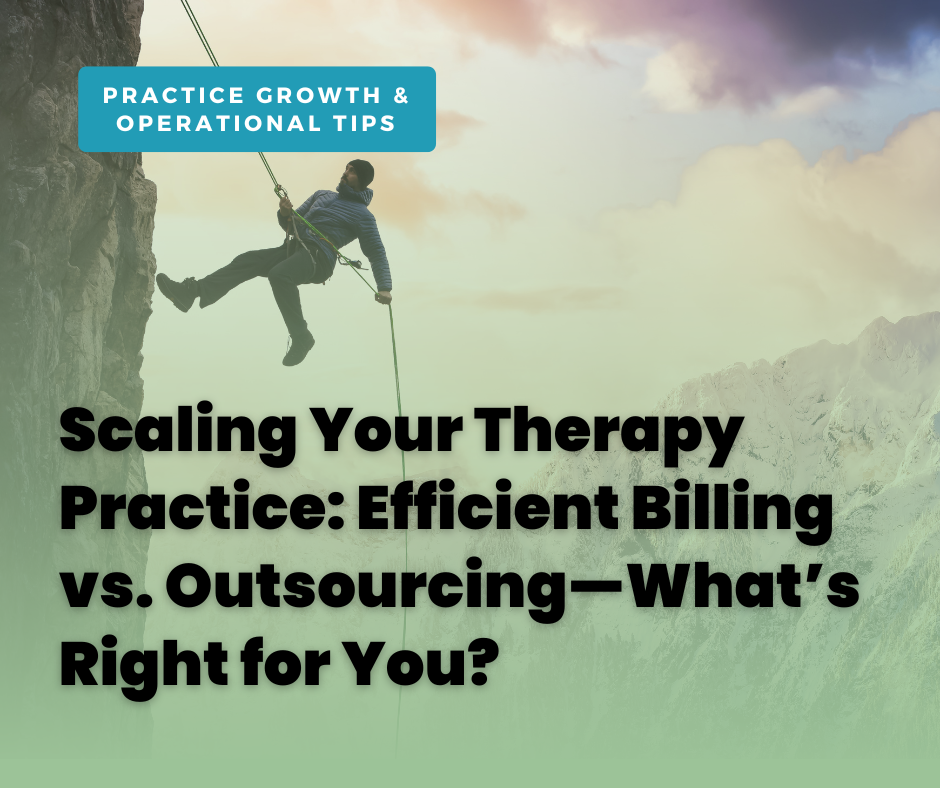HIPAA Compliance & Audit Readiness: A Billing Survival Guide for ABA, Speech, and OT Providers
- Essential Speech & ABA Therapy

- Aug 14
- 4 min read

For ABA, speech, and occupational therapy providers, billing is more than just claims and payments—it’s a high-stakes process that intersects with federal privacy regulations and payer scrutiny.
As practices grow and regulations tighten, it’s no longer enough to just submit claims and hope for the best. You must protect sensitive patient information under HIPAA, while also preparing for the possibility of payer audits that could jeopardize reimbursements if your processes aren’t airtight.
This guide outlines how to align your billing practices with HIPAA compliance and develop a culture of audit readiness so your practice stays secure, organized, and financially healthy.
Part 1: HIPAA Compliance in Billing—Why It Matters
The Health Insurance Portability and Accountability Act (HIPAA) is designed to protect patient privacy and ensure the secure handling of health information. But for providers and billing teams, it also adds a layer of responsibility. Violations can result in hefty fines, legal consequences, and reputational damage—even if they’re unintentional.
Here’s how to make sure your billing operations are HIPAA-compliant:
1. Secure Patient Data at All Times
Every billing task—submitting claims, checking eligibility, storing authorizations—involves Protected Health Information (PHI). HIPAA requires that this data be secured from unauthorized access.
Tips:
Use HIPAA-compliant billing software that offers end-to-end encryption, audit trails, and access controls. Your EHR, practice management system, and communication tools should all be secure.
Don’t use free or non-secure platforms (like Gmail or Google Sheets without protections) for storing or transmitting patient data.
2. Control Who Has Access to PHI
Only authorized personnel should be able to access billing information. This applies to both your internal team and any third-party vendors (like billing companies or consultants).
Tips:
Implement Role-Based Access Controls (RBAC) and maintain updated access logs. Each team member should have specific permissions based on their job duties.
Have staff sign confidentiality agreements and provide initial and ongoing HIPAA training.
3. Use Secure Communication Channels
When sending PHI—whether it’s to an insurance company, another provider, or a parent—HIPAA requires the use of secure transmission methods.
Tips:
Avoid standard email unless it’s encrypted. Instead, use secure email portals, fax services with encryption, or HIPAA-compliant messaging platforms for all communication containing PHI.
Establish a standard protocol for all billing-related communications that includes subject-line labels like “SECURE” or “PHI” to promote awareness.
4. Store Records Correctly and Legally
HIPAA mandates that medical records and billing documentation be stored securely and retained for a specific time frame (usually 6 years or more, depending on state law).
Tips:
Invest in a cloud-based storage system with multi-layer security. Make sure records are organized, indexed, and easily retrievable during audits or client inquiries.
Don’t forget to implement proper destruction protocols for expired files—shredding physical documents and using secure deletion for digital records.
5. Train Your Staff—And Train Them Often
The greatest HIPAA risk isn't always technology—it’s human error. Staff who don’t fully understand the importance of privacy can accidentally expose your practice to violations.
Tips:
Conduct HIPAA training for all employees at hire, then hold refresher courses at least once per year.
Use real-life billing scenarios in training to keep it relevant and actionable.
Part 2: Be Audit-Ready—Always
HIPAA isn’t the only compliance risk. Therapy practices are also subject to payer audits, which can happen randomly or due to red flags like high utilization, frequent resubmissions, or improper billing codes.
While audits are often stressful, a well-prepared team can handle them with confidence. Here's how to proactively build an audit-ready billing process.
1. Maintain Detailed, Consistent Documentation
If it’s not documented, it didn’t happen—at least in the eyes of an auditor. Whether it’s a session note, treatment plan, or authorization request, your documentation must support every billed service.
Tips:
Use standardized templates for all clinical documentation and ensure that session notes:
Clearly reflect the time billed
Match the authorized services
Include treatment goals and progress
Train clinicians on what auditors look for in notes. Incomplete or vague notes are one of the top reasons for recoupment.
2. Stay Current with Payer Policies
Insurance companies regularly update billing rules, diagnosis codes, authorization requirements, and service definitions. Relying on outdated information is a fast track to denials—or worse, an audit.
Tips:
Assign a team member to review payer policies quarterly and notify the team of any relevant changes.
Subscribe to payer newsletters or portals to stay in the loop.
3. Conduct Internal Billing Audits
Don’t wait for a payer audit to find out something’s wrong. By regularly reviewing your own records, you can catch issues like overbilling, missing documents, or coding inconsistencies before they become liabilities.
Tips:
Perform internal audits every quarter (or monthly for high-volume practices).
Include:
A random sample of claims
Matching notes to billed codes
Confirmation of prior authorizations
Document findings and follow up with team training or corrections as needed.
4. Keep Your Claims System Clean and Organized
An audit may require you to produce proof of service, progress notes, authorizations, and payment records—sometimes within days. If your claims are scattered across spreadsheets, sticky notes, or inboxes, you’ll lose valuable time and credibility.
Tips:
Use a centralized claims tracking system where every claim is logged from submission to payment. Make sure:
All documents are attached and linked
Notes are complete and date-stamped
Denials and corrections are documented
This system not only supports audits but also improves cash flow by preventing revenue leaks.
5. Designate a Go-To Audit Contact
When an audit notice comes in, someone must take charge. Having a designated person who understands the audit process can reduce stress and keep things moving smoothly.
Tips:
Identify a Compliance or Billing Lead who:
Manages audit requests
Coordinates document collection
Communicates with auditors
Tracks deadlines and responses
Train this person thoroughly and include them in any HIPAA or audit-prep training.
Final Thoughts: Trust, Compliance, and Growth Go Hand in Hand
HIPAA compliance and audit readiness may not feel exciting—but they’re essential to the health of your therapy practice.
When your billing processes are secure, documented, and up-to-date, you:
Avoid legal and financial penalties
Reduce audit stress and delays
Build trust with clients and payers
Create a foundation for scalable, ethical growth
Want help navigating HIPAA compliance or audit preparation? Essential Billing Solutions specializes in building secure, compliant, and organized billing workflows for ABA, speech, and OT providers.
Whether you need help with encryption, documentation reviews, or a full audit-readiness plan—we’ve got you covered!


